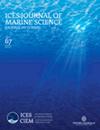中大西洋海湾冷池与近海风电租赁区之间的重叠
IF 3.4
2区 农林科学
Q1 FISHERIES
引用次数: 0
摘要
大西洋中部冷池是延伸至整个大西洋中部海湾(MAB)的季节性底层冷水团。冷池由春季表面迅速变暖形成,秋季因风暴等混合事件而消散。冷池支持着 MAB 沿海生态系统以及具有经济价值的商业和休闲渔业。近年来,人与生物圈内的近海风能发展迅速。欧洲的研究表明,近海风电场会影响海洋混合,进而影响季节性分层;但有关人与生物圈风能开发将如何影响冷池的信息还很有限。利用数据同化海洋模型的输出结果,评估了冷池与人与生物圈风电场施工前离海岸不同距离的风电租赁区域之间的季节重叠。结果突出显示了重叠期以及在底层温度升高到通常用于识别冷池的临界值之后持续存在的热梯度。这些结果还证明了冷池演化过程中的跨大陆架变异性。这项工作强调了对风电场对人与生物圈沿岸环境影响进行更有针对性的海洋建模研究和观测的必要性。本文章由计算机程序翻译,如有差异,请以英文原文为准。
Overlap between the Mid-Atlantic Bight Cold Pool and offshore wind lease areas
The Mid-Atlantic Cold Pool is a seasonal mass of cold bottom water that extends throughout the Mid-Atlantic Bight (MAB). Formed from rapid vernal surface warming, the Cold Pool dissipates in the fall due to mixing events such as storms. The Cold Pool supports a myriad of MAB coastal ecosystems and economically valuable commercial and recreational fisheries. Offshore wind energy has been rapidly developing within the MAB in recent years. Studies in Europe demonstrate that offshore wind farms can impact ocean mixing and hence seasonal stratification; there is, however, limited information on how MAB wind development will affect the Cold Pool. Seasonal overlap between the Cold Pool and pre-construction wind lease areas at varying distances from shore in the MAB was evaluated using output from a data-assimilative ocean model. Results highlight overlap periods as well as a thermal gradient that persists after bottom temperatures warm above the threshold typically used to identify the Cold Pool. These results also demonstrate cross-shelf variability in Cold Pool evolution. This work highlights the need for more focused ocean modeling studies and observations of wind farm effects on the MAB coastal environment.
求助全文
通过发布文献求助,成功后即可免费获取论文全文。
去求助
来源期刊

ICES Journal of Marine Science
农林科学-海洋学
CiteScore
6.60
自引率
12.10%
发文量
207
审稿时长
6-16 weeks
期刊介绍:
The ICES Journal of Marine Science publishes original articles, opinion essays (“Food for Thought”), visions for the future (“Quo Vadimus”), and critical reviews that contribute to our scientific understanding of marine systems and the impact of human activities on them. The Journal also serves as a foundation for scientific advice across the broad spectrum of management and conservation issues related to the marine environment. Oceanography (e.g. productivity-determining processes), marine habitats, living resources, and related topics constitute the key elements of papers considered for publication. This includes economic, social, and public administration studies to the extent that they are directly related to management of the seas and are of general interest to marine scientists. Integrated studies that bridge gaps between traditional disciplines are particularly welcome.
 求助内容:
求助内容: 应助结果提醒方式:
应助结果提醒方式:


